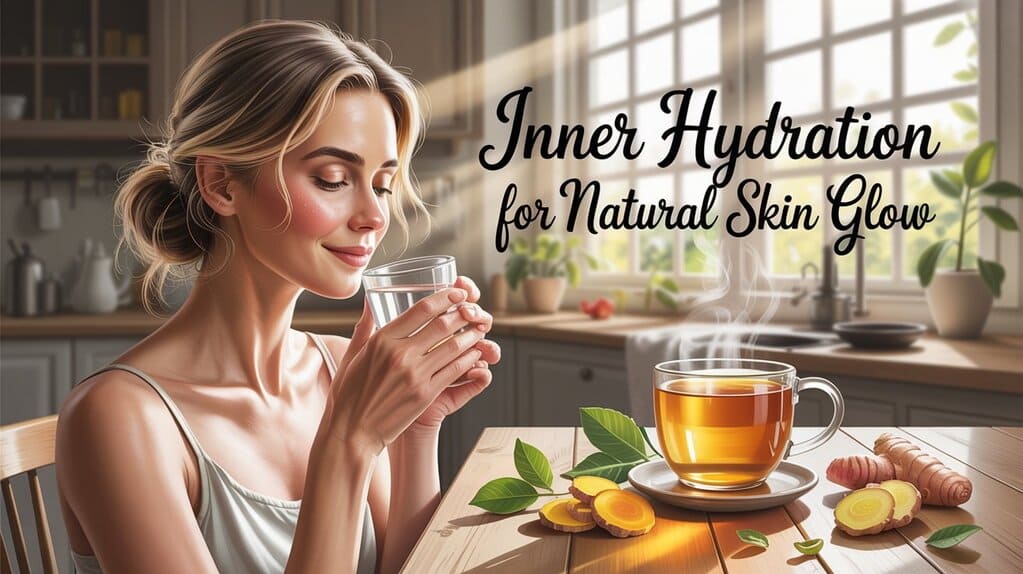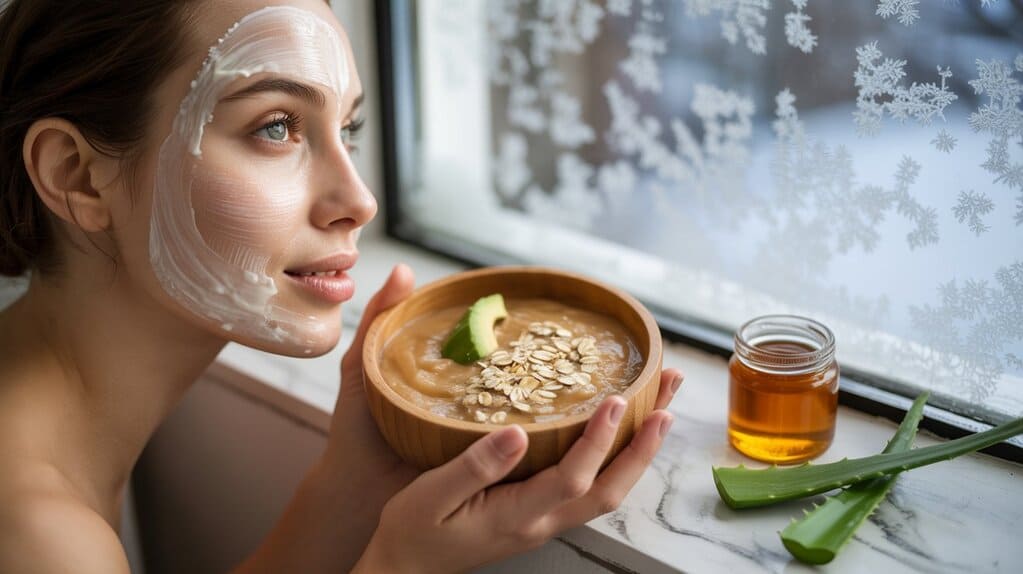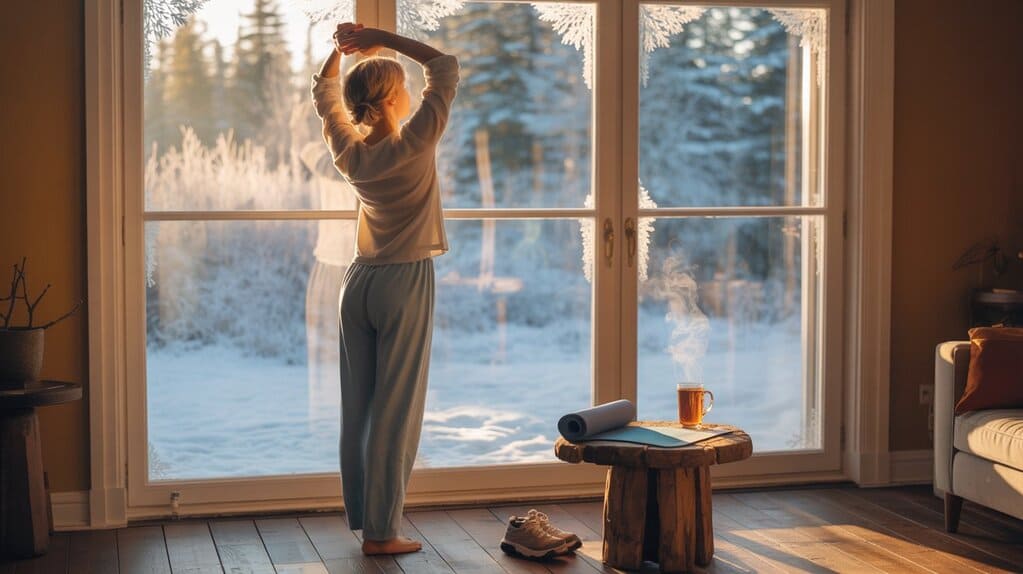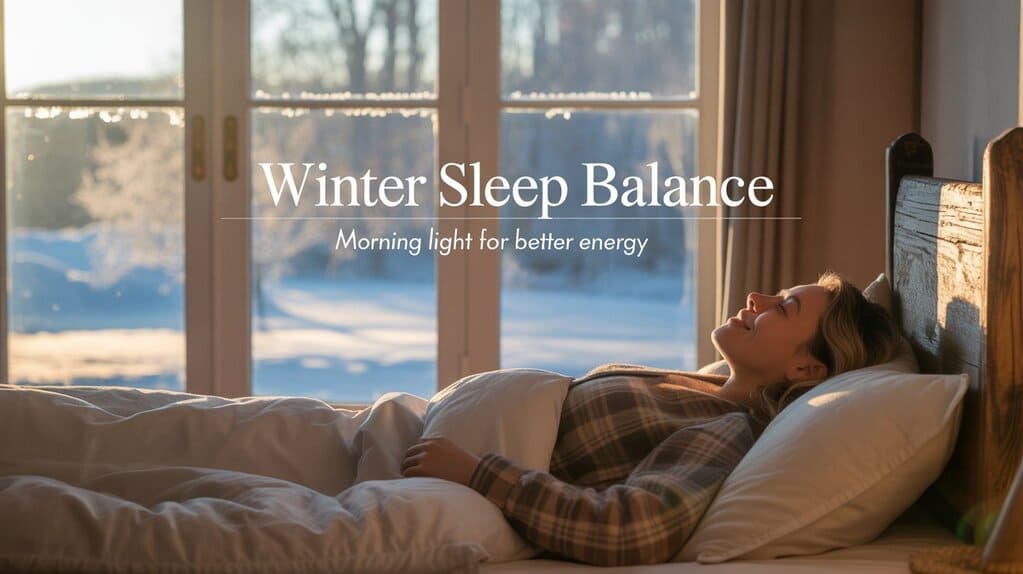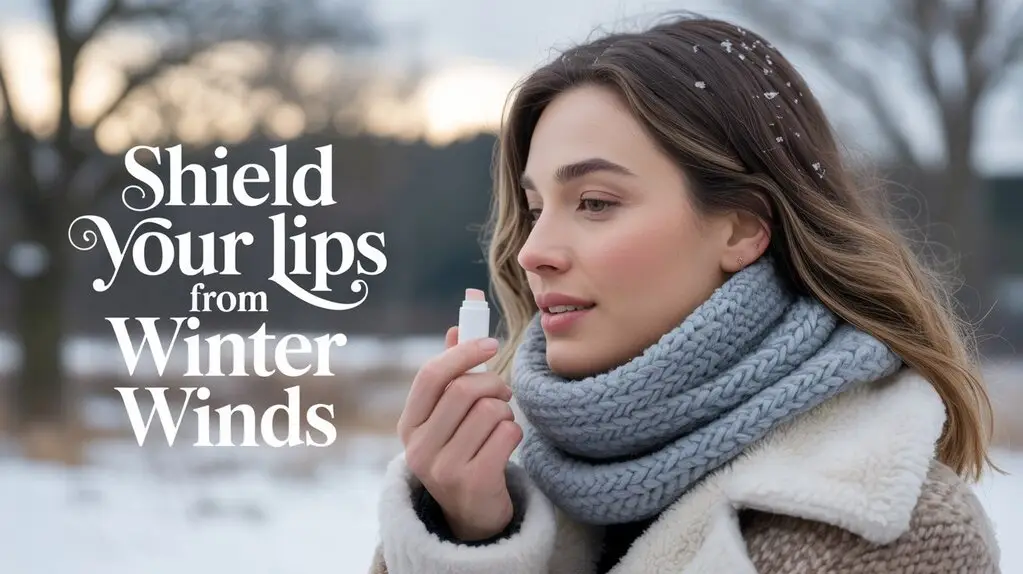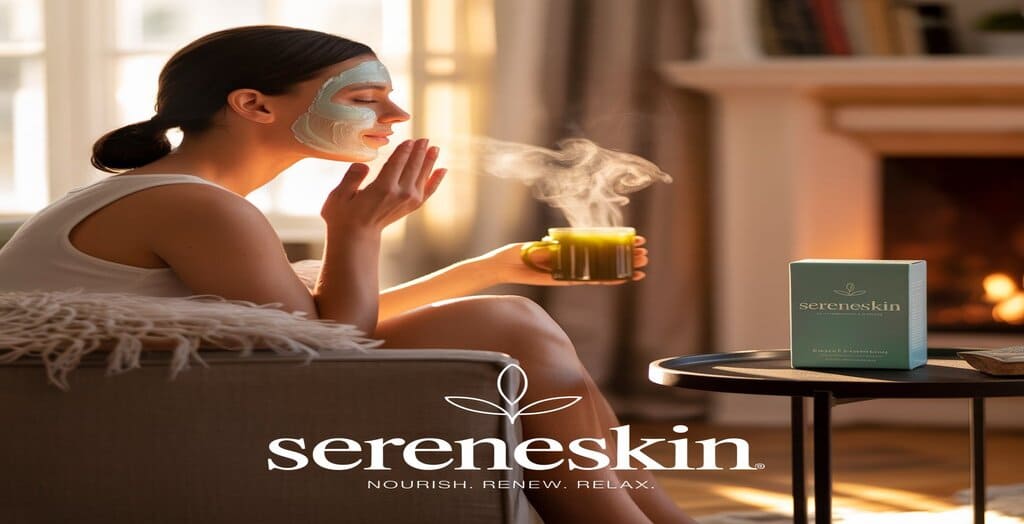
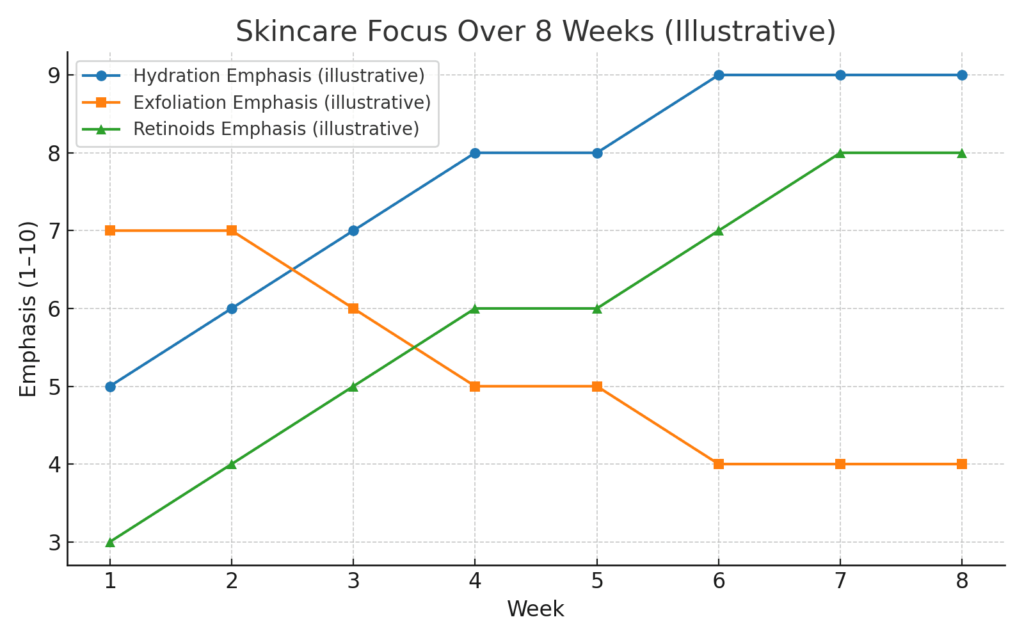
Introduction :
Why This Seasonal Shift Matters
As the calendar flips from late summer to the first crisp weeks of fall, your skin faces two meaningful environmental pivots. First, UV exposure decreases but does not disappear—UVA (linked to photoaging) remains relatively steady year-round and can penetrate window glass, while UVB (sunburn) falls more sharply yet still peaks around midday. Second, outdoor and indoor humidity typically trend downward, especially once heating starts, making the skin barrier more vulnerable to dryness and irritation. In practice, that means your routine needs small, strategic adjustments: maintain broad-spectrum SPF 30+, emphasize hydration, support the stratum corneum with ceramides, and phase in retinoids methodically to reap benefits without unnecessary irritation. (Académie Américaine de Dermatologie)
A quick refresher: the outermost skin layer—the stratum corneum—is a “brick-and-mortar” structure of protein-rich corneocytes (bricks) and lipids (mortar) such as ceramides, cholesterol, and fatty acids. This barrier limits transepidermal water loss (TEWL) and shields against irritants. TEWL is widely used as an index of barrier function in clinical and research settings, and lower humidity is a recognized stressor for barrier integrity. (Wikipédia, PMC, Wiley Online Library)
Illustrative visuals:
• Chart 1 suggests a typical pattern from August → November: UV index drifts downward while indoor relative humidity also drops.
• Chart 2 shows how to rebalance your routine across eight weeks—increase hydration, pull back on aggressive exfoliation, and ramp up retinoids slowly. (These are educational visuals, not location-specific forecasts.)
Key Points
- SPF stays essential. Use broad-spectrum SPF 30+ and reapply every ~2 hours outdoors; clouds and cooler temps do not eliminate UV exposure. (Académie Américaine de Dermatologie, U.S. Food and Drug Administration)
- Reinforce the barrier. Favor ceramide-rich moisturizers plus humectants (glycerin, hyaluronic acid); add occlusives (e.g., petrolatum) to curb TEWL in drier air. (PMC)
- Add niacinamide (2–5%). This well-tolerated ingredient supports barrier lipids, tone, and redness with growing mechanistic and clinical evidence. (PMC)
- Retinoids work—start slow. Tretinoin (Rx) has robust data for photoaging; ramp up gradually during dryer weather to minimize irritation. (PMC, PubMed)
- Control your micro-climate. Aim for 40–50% indoor humidity, shorter lukewarm showers, and fragrance-free formulas to reduce irritation risk. (PMC)
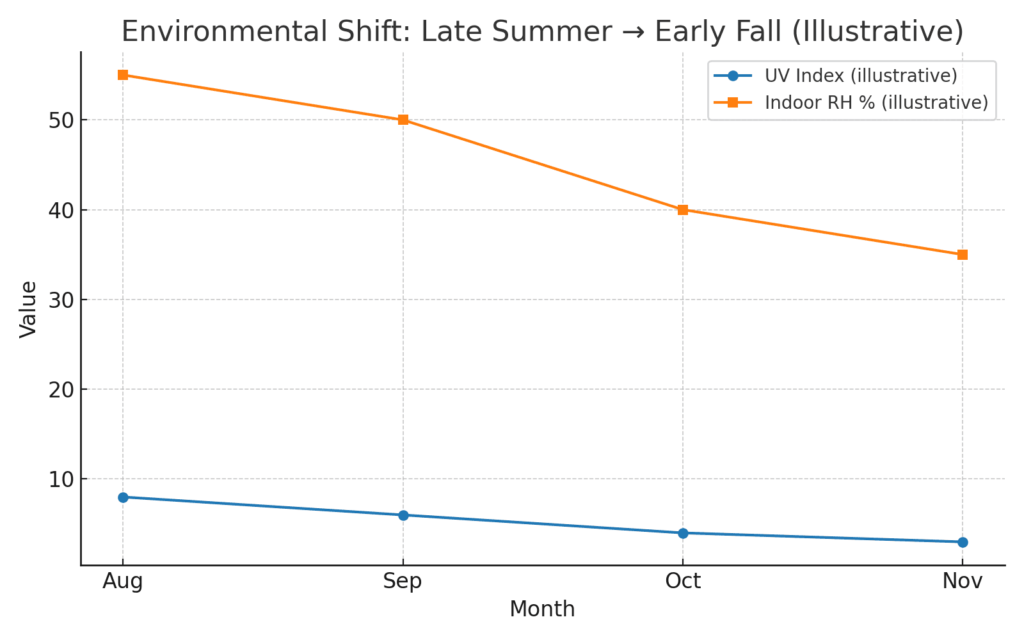
The Science of Seasonal Skin : UV, Humidity, and TEWL
UV exposure in early fall. Despite shorter days, UVA persists and UVB still matters around midday. Dermatology and public-health groups advise year-round sun protection with broad-spectrum products, correct dosing, and routine reapplication. Misconceptions—like using higher SPF to “stretch” reapplication—are actively flagged by dermatologists and health agencies; application amount and frequency remain critical. (Académie Américaine de Dermatologie, U.S. Food and Drug Administration)
Humidity and the barrier. Low humidity is associated with barrier stress; TEWL remains a key index in clinical and research practice. As air dries, the “mortar” lipids can crack, driving tightness, flaking, and sensitivity. That’s why fall routines should emphasize ceramides, humectants, and gentle cleansing while avoiding unnecessary irritation from over-exfoliation. (PMC, Wiley Online Library)

Evidence-Based Ingredients for the Transition
1) Ceramides (with Cholesterol + Fatty Acids)
- Why they matter: Ceramides help restore the barrier’s lipid “mortar,” reducing dryness and supporting comfort and resilience. A randomized trial showed a ceramide-dominant moisturizer-and-cleanser regimen improved barrier function and signs/symptoms in adults with moderate eczema—supporting barrier-first strategies for drier seasons as well. (PMC)
- How to use: Apply a ceramide cream morning and evening; layer over damp skin to trap water. Add a thin occlusive on hot-spots (around nose/mouth) at night to reduce TEWL in low humidity. (PMC)
2) Niacinamide (Nicotinamide)
- Why it’s helpful: Niacinamide is multifunctional—supporting barrier lipids, calming redness, and improving tone/textural unevenness. Reviews in 2021 and 2024 summarize mechanistic and clinical data, including effects on oxidative stress, pigmentation pathways, and skin aging markers. (PMC)
- How to use: 2–5% once or twice daily. It pairs well with ceramides and hyaluronic acid and is generally well tolerated in drier weather. For background, see the Nicotinamide page on Wikipedia. (Wikipédia)
3) Retinoids (Retinol, Retinal, Tretinoin)
- Why they shine now: Cooler months are often easier for introducing or escalating retinoids because sun intensity is lower (though still present). Tretinoin remains a gold-standard topical for photoaging with a strong body of RCTs and systematic reviews. (PMC, PubMed)
- How to use: Start 2–3 nights per week, pea-sized amount for the full face, and buffer with moisturizer. Expect a brief adaptation period (dryness or mild peeling). If you prefer OTC, retinol can help with tone/texture, though evidence is generally less robust than tretinoin. For general background on sunscreen’s role alongside retinoids, Wikipedia’s Sunscreen article is helpful. (Wikipédia)
4) Sunscreen (Broad-Spectrum, SPF 30+)
- The bottom line: Continue SPF 30+ daily on exposed areas and reapply outdoors every ~2 hours or after sweating/swimming. Authoritative guidance from the American Academy of Dermatology and the U.S. FDA emphasizes technique and reapplication, not just the SPF number. (Académie Américaine de Dermatologie, U.S. Food and Drug Administration)
- Why this matters in fall: UVA penetrates clouds and glass; relying on cooler weather or higher SPF alone is a mistake. (Dermatologists continue to debunk the idea that “SPF 100 means you don’t need to reapply.”) (Académie Américaine de Dermatologie)
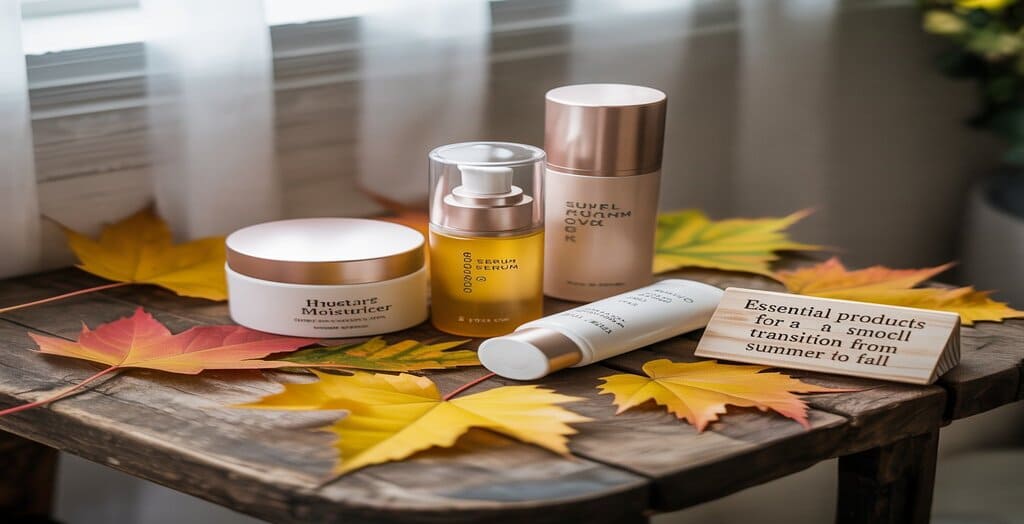
Practical Routine : Late Summer → Early Fall
Morning (Protect + Hydrate)
- Gentle Cleanser (pH-balanced; avoid harsh sulfates as air dries).
- Niacinamide serum (2–5%) to support barrier lipids and tone. (PMC)
- Ceramide moisturizer (optionally with glycerin or hyaluronic acid). (PMC)
- Broad-spectrum SPF 30+ (mineral or chemical) with even coverage; reapply outdoors. (Académie Américaine de Dermatologie)
Evening (Repair + Regenerate)
- Double cleanse if you used long-wear makeup/water-resistant SPF.
- Retinoid (start low and slow). Tretinoin shows consistent benefits for photoaging in RCTs and reviews; buffer with moisturizer to reduce irritation. (PMC)
- Ceramide cream; dab an occlusive on the driest spots to limit TEWL overnight. (PMC)
Weekly Add-Ons (Adjust to Your Skin)
- Gentle exfoliation ≤ 1×/week (low-strength AHA/PHA). Over-exfoliation plus low humidity is a recipe for redness—pause if irritation emerges.
- Hydration mask as needed (look for humectants like glycerin and hyaluronic acid).
- Humidifier targeting ~40–50% RH, shorter lukewarm showers, and fragrance-free products to reduce barrier stress. (PMC)

Table: Transition Playbook (What to Increase vs. Decrease)
| Aspect | Late Summer (Hotter, More UV) | Early Fall (Cooler, Drier) | Why |
|---|---|---|---|
| Sunscreen | SPF 30+, frequent reapplication | SPF 30+ continues, same reapplication | UVA persists; technique beats SPF “number chasing.” (Académie Américaine de Dermatologie) |
| Hydration | Light lotions/gel creams | Richer ceramide creams, add occlusive on hotspots | Drier air elevates TEWL; lipids + humectants help. (PMC) |
| Exfoliation | Up to 1–2×/week (tolerance-dependent) | Dial down to ≤ 1×/week | Over-exfoliation + low humidity = irritation risk. |
| Retinoids | Maintain or hold steady | Gradual ramp (2–3 nights/week → more) | Strong evidence for tretinoin in photoaging. (PMC) |
| Cleansing | Foam/gel ok if not drying | Gentle, pH-balanced; avoid harsh surfactants | Preserve barrier lipids as humidity declines. |
Charts (Illustrative Aids)
- Chart 1 – UV vs. Indoor Humidity (Aug–Nov): Suggests how UV index and indoor RH may trend during the transition (illustrative).
- Chart 2 – Skincare Focus Over 8 Weeks: Emphasis shifts—hydration trends upward; exfoliation dials back; retinoids ramp cautiously.
These visuals are educational, not forecasts for your exact location. Always tailor to your climate and personal tolerance.
Frequently Asked Questions
Q1: Do I still need sunscreen in early fall?
Yes. Use broad-spectrum SPF 30+ and reapply outdoors every ~2 hours. UVA remains significant even on cloudy, cooler days, and through window glass. Technique and reapplication matter more than chasing the highest possible SPF number. Authoritative bodies like the AAD and FDA stress correct application. (Académie Américaine de Dermatologie, U.S. Food and Drug Administration)
Q2: Which is better in fall—mineral or chemical sunscreen?
Both can be effective if broad-spectrum and used correctly. Mineral filters (zinc oxide/titanium dioxide) are often favored by sensitive skin; chemical options can feel lighter. Choose what you will consistently apply and reapply. For general background, see Wikipedia’s Sunscreen entry. (Wikipédia)
Q3: Is now a good time to start a retinoid?
Often yes, if you go slow. Tretinoin has strong evidence for photoaging benefits; use a pea-sized amount, buffer with moisturizer, and increase frequency as tolerated. (PMC)
Q4: What makes niacinamide so popular for seasonal transitions?
It’s versatile, well-tolerated, and supports barrier lipids and tone. Reviews in 2021 and 2024 summarize its mechanisms and clinical use. (PMC)
Conclusion :
Small Adjustments, Big Payoff
Maintaining beautiful skin as summer fades into fall is about smart micro-adjustments rather than a total overhaul. Keep SPF 30+ in the daily lineup and reapply when outdoors, feed the barrier with ceramides + humectants, fold in niacinamide for its multi-benefit support, ramp retinoids carefully for long-term gains, and protect your home micro-climate with a humidifier and gentler cleansing habits. With consistent, evidence-based care, your skin can stay smooth, calm, and radiant throughout the seasonal shift.
References & Further Reading (Selected)
- TEWL / Barrier & Humidity
• Seno S. Quantitative evaluation of skin barrier function using water evaporation. 2022 (PMC). TEWL as an index for barrier function. (PMC)
• Seno S. Quantitative evaluation … (Wiley abstract). 2023. TEWL measurement context. (Wiley Online Library)
• Mayrovitz HN. TEWL and stratum corneum hydration. 2023 (PMC). Measurement and physiology overview. (PMC)
• Wikipedia: Stratum corneum (background). (Wikipédia) - Ceramides
• Spada F. et al. Ceramide-dominant moisturizer + cleanser regimen in adult eczema (RCT). 2021 (PMC). (PMC) - Niacinamide
• Boo YC. Mechanistic Basis and Clinical Evidence for the Topical Use of Niacinamide. 2021 (PMC). (PMC)
• Marques C. Mechanistic Insights into Niacinamide’s Multiple Functions. 2024 (PMC). (PMC)
• Wikipedia: Nicotinamide (background). (Wikipédia) - Retinoids
• Sitohang IBS et al. Topical tretinoin for photoaging: systematic review of RCTs. 2022 (PMC). (PMC)
• Siddiqui Z. Comparing tretinoin to other topical therapies (systematic review). 2024 (PubMed). (PubMed) - Sunscreen Guidance
• American Academy of Dermatology – Sunscreen FAQs & application guidance. (Académie Américaine de Dermatologie)
• U.S. FDA – Sunscreen: How to Help Protect Your Skin from the Sun (reapplication every ~2 hours; layered protection). (U.S. Food and Drug Administration)
• Wikipedia: Sunscreen (overview). (Wikipédia)
Note on visuals : The two charts above are illustrative to help you plan routine changes during the transition from late summer to early fall. For personalized advice, consult a board-certified dermatologist.
